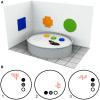From objects to landmarks: the function of visual location information in spatial navigation
- PMID: 22969737
- PMCID: PMC3427909
- DOI: 10.3389/fpsyg.2012.00304
From objects to landmarks: the function of visual location information in spatial navigation
Abstract
Landmarks play an important role in guiding navigational behavior. A host of studies in the last 15 years has demonstrated that environmental objects can act as landmarks for navigation in different ways. In this review, we propose a parsimonious four-part taxonomy for conceptualizing object location information during navigation. We begin by outlining object properties that appear to be important for a landmark to attain salience. We then systematically examine the different functions of objects as navigational landmarks based on previous behavioral and neuroanatomical findings in rodents and humans. Evidence is presented showing that single environmental objects can function as navigational beacons, or act as associative or orientation cues. In addition, we argue that extended surfaces or boundaries can act as landmarks by providing a frame of reference for encoding spatial information. The present review provides a concise taxonomy of the use of visual objects as landmarks in navigation and should serve as a useful reference for future research into landmark-based spatial navigation.
Keywords: hippocampus; landmarks; navigation; parahippocampal gyrus; retrosplenial cortex; spatial memory; striatum; topographical disorientation.
Figures



Similar articles
-
Representation of visual landmarks in retrosplenial cortex.Elife. 2020 Mar 10;9:e51458. doi: 10.7554/eLife.51458. Elife. 2020. PMID: 32154781 Free PMC article.
-
Inactivation of the Lateral Entorhinal Area Increases the Influence of Visual Cues on Hippocampal Place Cell Activity.Front Syst Neurosci. 2017 May 29;11:40. doi: 10.3389/fnsys.2017.00040. eCollection 2017. Front Syst Neurosci. 2017. PMID: 28611603 Free PMC article.
-
Encoding and retrieval of landmark-related spatial cues during navigation: an fMRI study.Hippocampus. 2014 Jul;24(7):853-68. doi: 10.1002/hipo.22275. Epub 2014 May 2. Hippocampus. 2014. PMID: 24706395
-
Representation of human spatial navigation responding to input spatial information and output navigational strategies: An ALE meta-analysis.Neurosci Biobehav Rev. 2019 Aug;103:60-72. doi: 10.1016/j.neubiorev.2019.06.012. Epub 2019 Jun 12. Neurosci Biobehav Rev. 2019. PMID: 31201830 Review.
-
On the assessment of landmark salience for human navigation.Cogn Process. 2008 Dec;9(4):249-67. doi: 10.1007/s10339-007-0199-2. Epub 2007 Nov 13. Cogn Process. 2008. PMID: 17999102 Review.
Cited by
-
The Occipital Place Area Is Recruited for Echo-Acoustically Guided Navigation in Blind Human Echolocators.J Neurosci. 2023 Jun 14;43(24):4470-4486. doi: 10.1523/JNEUROSCI.1402-22.2023. Epub 2023 May 1. J Neurosci. 2023. PMID: 37127360 Free PMC article.
-
This Place Looks Familiar-How Navigators Distinguish Places with Ambiguous Landmark Objects When Learning Novel Routes.Front Psychol. 2015 Dec 24;6:1936. doi: 10.3389/fpsyg.2015.01936. eCollection 2015. Front Psychol. 2015. PMID: 26733921 Free PMC article.
-
Chronic alcohol consumption shifts learning strategies and synaptic plasticity from hippocampus to striatum-dependent pathways.Front Psychiatry. 2023 May 26;14:1129030. doi: 10.3389/fpsyt.2023.1129030. eCollection 2023. Front Psychiatry. 2023. PMID: 37304443 Free PMC article.
-
Putting emotions in routes: the influence of emotionally laden landmarks on spatial memory.Psychol Res. 2019 Jul;83(5):1083-1095. doi: 10.1007/s00426-018-1015-6. Epub 2018 Apr 16. Psychol Res. 2019. PMID: 29663133
-
Canonical cortico-hippocampal dynamics underlie memory of navigational episodes and its early decline in aging.Imaging Neurosci (Camb). 2025 Aug 18;3:IMAG.a.101. doi: 10.1162/IMAG.a.101. eCollection 2025. Imaging Neurosci (Camb). 2025. PMID: 40837883 Free PMC article.
References
-
- Able K. P. (1991). Common themes and variations in animal orientation systems. Am. Zool. 31, 157–167
-
- Alyan S. (1996). Evidence for resetting the directional component of path integration in the house mouse (Mus musculus). Ethology 102, 629–63810.1111/j.1439-0310.1996.tb01154.x - DOI
-
- Alyan S., Jander R. (1994). Short-range homing in the house mouse, Mus musculus: stages in the learning of directions. Anim. Behav. 48, 285–29810.1006/anbe.1994.1242 - DOI
LinkOut - more resources
Full Text Sources

